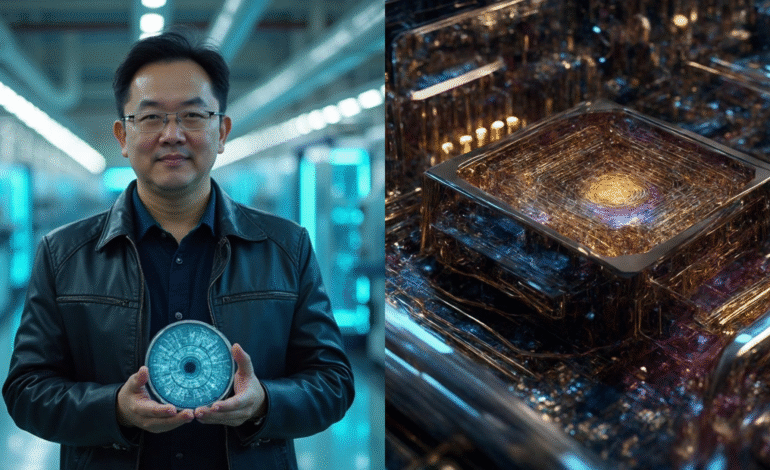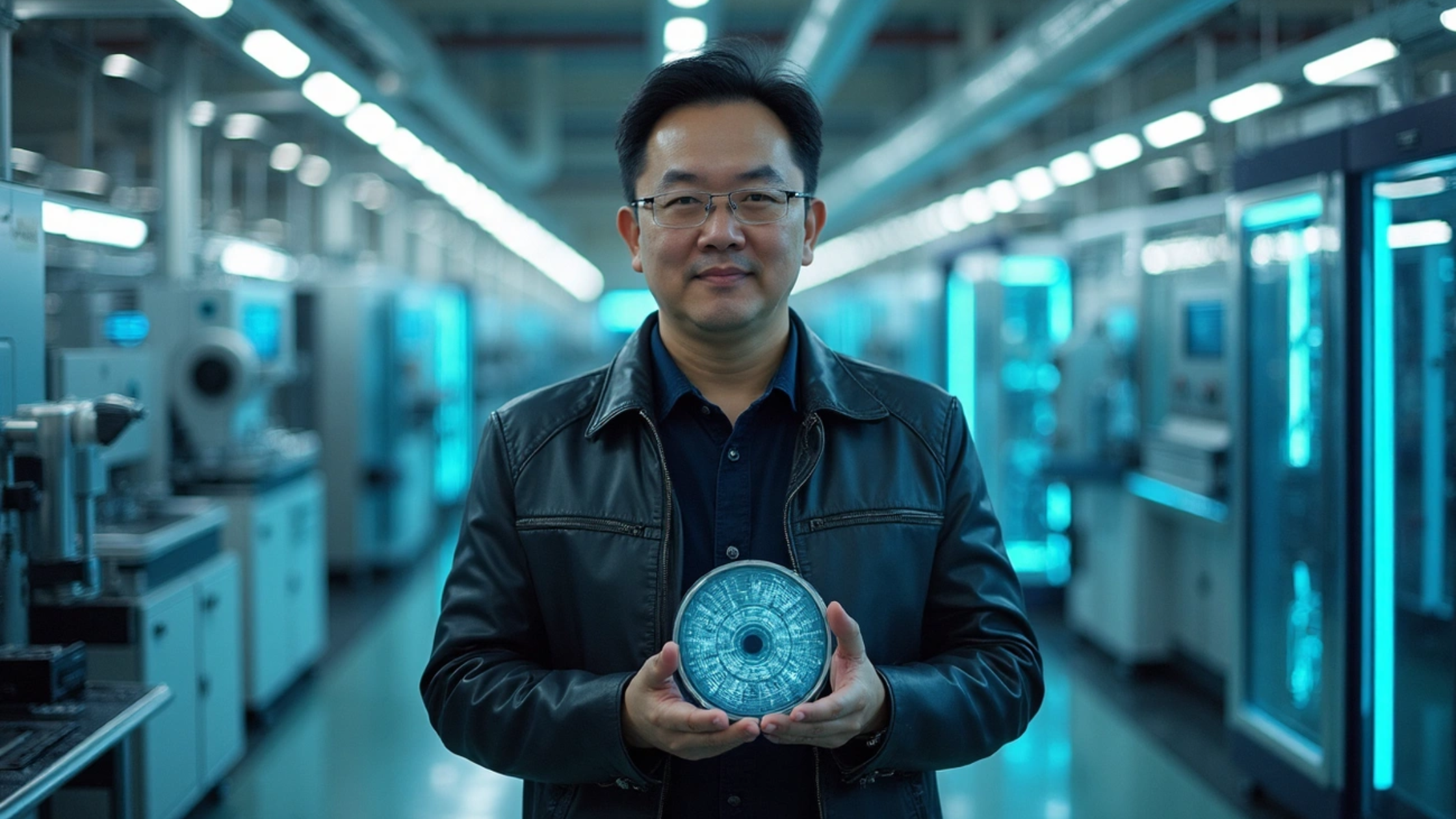Nvidia CEO Jensen Huang to Visit Beijing Before China AI Chip Launch

Nvidia CEO Jensen Huang is making headlines with plans to visit Beijing ahead of launching a new AI chip designed specifically for the Chinese market. We’ve been closely watching this development as it represents a significant move in the ongoing tech relationship between the US and China.
Recently, this Jensen Huang news has captured attention because the trip marks his first high-profile visit to China since US export restrictions were imposed. Despite these limitations, Jensen Huang appears committed to maintaining Nvidia’s presence in China, where the new Nvidia AI chip will need to comply with strict US regulations. Importantly, this visit highlights the delicate balance tech companies must maintain when operating in both markets during times of geopolitical tension.
Jensen Huang visits China ahead of AI chip launch

Nvidia’s co-founder and CEO has landed in Beijing for what represents a significant diplomatic effort amid ongoing US-China technology tensions. Jensen Huang arrived in the Chinese capital this week, with photos of him alongside Xiaomi CEO Lei Jun already circulating on Chinese social media platforms [1].
CEO’s itinerary includes meetings with Chinese tech leaders
Huang’s agenda appears ambitious as he seeks to strengthen Nvidia’s position in the crucial Chinese market. According to reliable sources, he is actively pursuing discussions with senior Chinese officials, including the commerce minister [2]. Furthermore, the Nvidia chief reportedly hopes to meet with Premier Li Qiang and Vice Premier He Lifeng, although these high-level engagements still await final confirmation from Chinese authorities [3].
The centerpiece of Huang’s visit is his participation in the International Supply Chain Expo in Beijing, scheduled from July 16 to 20 [1]. This government-backed event has previously featured prominent tech executives like Apple’s Tim Cook. Additionally, Huang will hold a media briefing on July 16 [4], likely addressing questions about Nvidia’s commitment to China despite increasing regulatory challenges.
Trip marks first high-profile visit since US export restrictions
This journey comes at a particularly sensitive moment for the semiconductor giant. Currently, Nvidia is restricted from selling its most advanced chips to Chinese customers, with only lower-end, gaming-focused graphics processors permitted under US regulations [2].
Nevertheless, Huang has remained outspoken about maintaining access to what he considers a vital market. Earlier this year, he publicly criticized Washington’s export control policies as counterproductive, arguing they have merely accelerated China’s domestic chip development while giving local competitors like Huawei an unintended advantage [3].
The visit has attracted significant attention in Washington as well. On Friday, a bipartisan pair of US senators—Republican Jim Banks and Democratic Senator Elizabeth Warren—sent Huang a cautionary letter regarding his China trip [5]. The lawmakers explicitly asked him to “abstain from meeting with companies that are working with military or intelligence bodies in the People’s Republic of China” [4].
Huang has consistently emphasized China’s strategic importance to Nvidia’s business model. According to the company’s latest annual report, China generated approximately AUD 25.99 billion in revenue for Nvidia in the fiscal year ended January 26, accounting for 13% of total sales [4].
Nvidia unveils new AI chip tailored for Chinese market

Reports indicate Nvidia is preparing to release a new artificial intelligence chip specifically designed for the Chinese market as early as September [6]. This strategic move coincides with Jensen Huang’s visit to China, where the Nvidia CEO aims to reaffirm the company’s commitment to the region.
Chip designed to comply with US export controls
The upcoming chip is a modified version of Nvidia’s Blackwell RTX Pro 6000 processor, specifically engineered to meet tightened US export regulations [6]. Nvidia is reportedly seeking assurances from Washington that this new product won’t breach current restrictions or face a ban shortly after launch [6]. This cautious approach follows the company’s experience with its H20 chip, which was effectively blocked from the Chinese market after US officials required an export license [7].
How the new chip differs from Nvidia’s global offerings
To comply with regulations, the China-specific chip will be stripped of its most advanced technologies [6]:
- No high-bandwidth memory (HBM)
- No NVLink high-speed interconnect capability
- Uses conventional GDDR7 memory instead
- Avoids Taiwan Semiconductor Manufacturing’s advanced Chip-on-Wafer-on-Substrate packaging technology [8]
These modifications result in a significantly lower price point—between AUD 9,938.44 and AUD 12,231.92—compared to the AUD 15,289.90 to AUD 18,347.88 that the H20 sold for [8]. Essentially, these technical compromises allow Nvidia to operate within the US regulatory framework that caps memory bandwidth at approximately 1.7-1.8 terabytes per second [9].
Expected performance and use cases in China
Even with reduced specifications, the new chip is expected to maintain Nvidia’s competitiveness against rising domestic players like Huawei with its Ascend 910B chip [9]. Primarily, this chip targets China’s booming inference market—where AI models are deployed rather than trained—which accounts for roughly 70% of AI spending in the region [10].
Nvidia plans to produce more than 1 million units of this chip (reportedly codenamed B30) this year [11]. Obviously, these modifications limit the chip’s suitability for cutting-edge AI training, restricting its appeal mainly to inference-focused applications [12].
Why Nvidia is doubling down on China despite tensions
Despite mounting geopolitical tensions between the US and China, Nvidia CEO Jensen Huang remains steadfast in his commitment to the Chinese market. His recent actions reflect a calculated strategy to maintain a foothold in Asia’s largest economy even as regulatory hurdles increase.
China remains a critical market for AI hardware
The financial numbers tell a compelling story about why Huang cannot afford to abandon China:
- The country generated AUD 25.99 billion in revenue for Nvidia, representing 13% of total sales last fiscal year [13][9]
- China’s AI chip market is projected to reach AUD 76.45 billion by 2026 [14]
- Half of the world’s AI developers are based in China [14]
Most telling, however, is the impact of US restrictions on Nvidia’s position in China. Huang recently revealed that the company’s market share has plummeted from 95% to approximately 50% since export controls began in 2022 [9][14]. This dramatic shift explains why Huang labeled the ongoing export restrictions “a failure” [14].
Balancing innovation with compliance
Huang has adopted a pragmatic approach to navigating complex regulations. Indeed, he publicly downplayed concerns about China’s military using US technology, stating they “simply can’t rely on it” as “it could be limited at any time” [15]. This position supports his argument that export controls are counterproductive to American tech leadership.
Consequently, Nvidia has pursued a strategy of creating compliant alternatives rather than abandoning the market altogether. The latest restrictions cost Nvidia AUD 8.41 billion in earnings [16], underscoring the financial imperative driving this approach.
Expert quotes on Nvidia’s China strategy
Industry analysts offer mixed assessments of Huang’s China strategy. Daniel Newman, CEO of The Futurum Group, described Huang as walking “a proverbial tightrope” between Washington and Beijing [15]. Conversely, Newman questioned Huang’s claim about military applications, noting it’s “hard to completely accept the idea that China couldn’t use Nvidia’s most advanced technologies for military use” [15].
Regardless of these concerns, Nvidia’s persistence in the Chinese market reflects its determination to maintain influence in a region crucial to global AI development.
How US-China tech rivalry shapes Nvidia’s roadmap
The technological cold war between the United States and China continues to reshape the semiconductor landscape, forcing Nvidia to navigate complex regulatory waters. This high-stakes rivalry has created a challenging environment where the chip giant must constantly recalibrate its strategy.
Overview of US export restrictions on AI chips
The Biden administration has progressively tightened export controls on advanced semiconductor technology to China since October 2022. These restrictions specifically target chips with particular computing power and memory bandwidth thresholds. In October 2023, the US government further intensified these rules by blocking shipments of Nvidia’s H20, L20, and L2 AI chips designed for the Chinese market. Moreover, the regulations now restrict chips with performance exceeding 4,800 TOPS or those utilizing high-bandwidth memory.
Such export controls have directly impacted Nvidia’s revenue, with the company losing approximately AUD 8.41 billion in potential earnings due to these restrictions. Nonetheless, the company continues seeking ways to serve the Chinese market while staying compliant with US regulations.
China’s push for semiconductor self-sufficiency
In response to these constraints, Beijing has intensified its drive toward technological independence. The Chinese government has allocated over AUD 214.06 billion to bolster its domestic semiconductor industry. This substantial investment aims to reduce reliance on foreign technology, especially in critical sectors like artificial intelligence.
As a result, domestic companies like Huawei have accelerated chip development. Huawei’s Ascend 910B chip now presents a formidable alternative to Nvidia’s offerings in the Chinese market. Interestingly, China’s artificial intelligence market, valued at roughly AUD 76.45 billion, has become a battleground where domestic players are gaining ground against international competitors.
Implications for global AI leadership
This technological competition extends beyond corporate interests to questions of global technological leadership. As jensen huang noted, export controls have inadvertently accelerated China’s domestic AI chip development rather than containing it. Before these restrictions, Nvidia dominated with approximately 95% market share in China’s AI chip market.
Currently, Nvidia’s Chinese market share has declined to about 50%, creating a bifurcated global AI ecosystem. This division potentially threatens interoperability and global collaboration in AI advancement. Furthermore, the increasing divergence between Chinese and Western AI ecosystems may lead to parallel technological tracks with different standards, algorithms, and capabilities.
Conclusion
Jensen Huang’s strategic visit to China undoubtedly marks a pivotal moment for Nvidia amid escalating US-China tech tensions. Throughout his meetings with Chinese tech leaders and government officials, Huang appears determined to safeguard Nvidia’s position in this crucial market despite facing significant regulatory headwinds. Certainly, the timing of this visit aligns perfectly with the company’s plans to release a modified Blackwell RTX Pro 6000 processor specifically engineered for Chinese customers.
The new chip represents a carefully calculated response to US export restrictions. Therefore, Nvidia has deliberately stripped advanced features like high-bandwidth memory and NVLink capabilities to ensure compliance with American regulations. This approach reflects Huang’s pragmatic strategy – rather than abandoning the Chinese market altogether, Nvidia chooses to adapt and compete where possible.
Nevertheless, the impact of export controls on Nvidia’s business cannot be overstated. Previously dominating with 95% market share, the company now holds approximately 50% as domestic competitors like Huawei gain ground. Meanwhile, China’s massive investment of over AUD 214 billion in its semiconductor industry has accelerated its push toward technological self-sufficiency.
Looking at the broader picture, this situation illustrates the complex reality tech giants face when caught between competing superpowers. Although Huang publicly downplays concerns about military applications of Nvidia technology, he still walks what analysts call “a proverbial tightrope” between Washington and Beijing. As a result, we might witness the emergence of parallel AI ecosystems with different standards and capabilities – a fundamental shift in global technology development that extends far beyond Nvidia’s business interests.








1 Comment
[…] China has witnessed a significant boost in its trade and investment engagement with countries involved in the Belt and Road Initiative (BRI), a development that is reshaping global economic alignments. This growth, highlighted by Vice Commerce Minister Li Chenggang during a recent press conference, is marked by a notable rise in both trade volume and two-way investments with Belt and Road countries. The expansion is not only strategic for China but also offers substantial implications for international stakeholders, including the UAE and wider Middle East region. […]
Comments are closed.